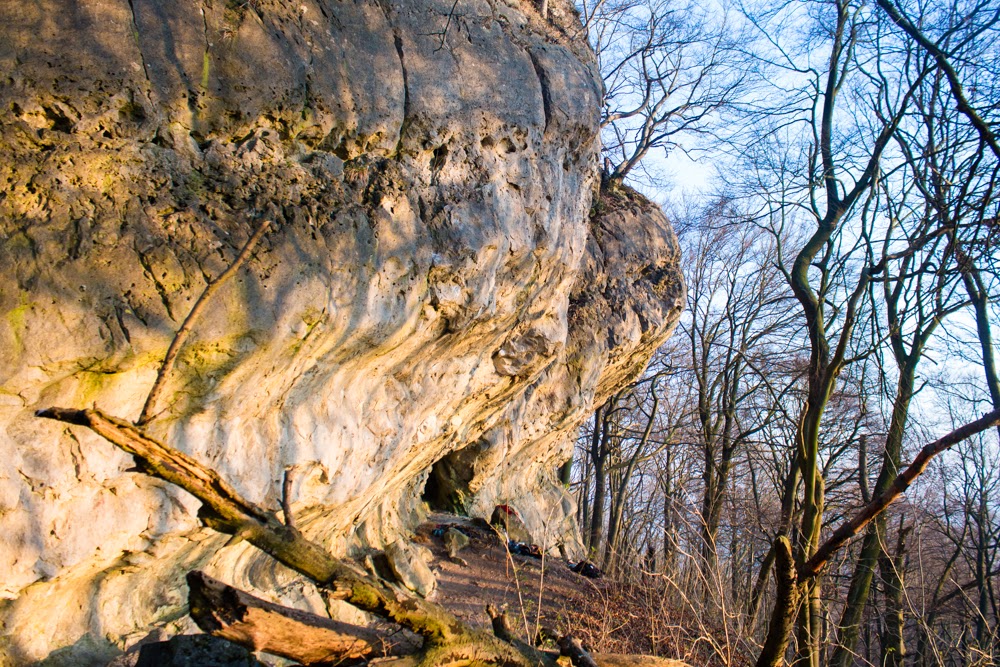Last week I enthusiastically wrote about starting a periodized training schedule. Truth is that I had already started it weeks before and this week I've completed the strength phase. The core exercise of this phase was doing isometric deadhangs on the fingerboard. I've approached it quite differently though compared to how I used to perform deadhang training. Previously I followed up the advice of Dave McLeod and Eva Lopez and aimed for a very small volume of very short, maximum intensity hangs (in my case a set of 12 single hangs I could hold for up to 8 seconds and then take several minutes of rest before the next hang). Such a routine aims for neurological adaptations exclusively.
In my current training program (based on the The Rock Climber's Training Manual by the Anderson brothers) neurological adaptations are primarily addressed in the power phase. In this case they are trained in the context dynamic movements, which is much more sports specific than isometric hangs and therefore makes a lot of sense to me. As the strength phase precedes the power phase, aiming for hypertrophy first is sensible and therefore a different approach to the exercises is required. So I switched to doing 'repeaters': sets of 7 second hangs separated by just 3 seconds of rest. Sets contain 6 or 7 hangs and are separated by 3 minute rests. With a harness, some weights and a pulley system the load can be carefully adjusted to aim for muscular failure at the last hang of each set and progressively increase the intensity through the strength phase. The basics are described elaborately in The Rock Climber's Training Manual and partly in this article plus video by Ned Feehally from Beastmaker fingerboards (see also the second part about the advanced routine).
The result of this regimen is a much higher training volume at a slightly reduced intensity, aiming for hypertrophy in the forearms (it should be noted though that most strength gains in this phase are still from neurological adaptations). I did 10 workouts, consisting of about an hour of progressive warming up (mostly by bouldering) followed by 13 sets of repeaters in varying grip positions (although I had to start with less, but could increase the volume quickly in the first 4 workouts) and finally some upper body and antagonist exercises. As predicted, I was able to increase the load consistently between the first workouts, but the gains started to diminish towards the end of the phase, which is the cue to progress to the power phase.
As hangboarding is extremely quantifiable, it's easy to keep track of progress and analyze workouts. I've made the following graphs from the data I collected during my trainings and they nicely show the progress through the strength phase. A list of the grip positions and their abbreviations can be found below.
As hangboarding is extremely quantifiable, it's easy to keep track of progress and analyze workouts. I've made the following graphs from the data I collected during my trainings and they nicely show the progress through the strength phase. A list of the grip positions and their abbreviations can be found below.
List of the grip positions (in chronological order):
- 'Big sloper': open handed hang on big sloper
- '4f open 18 mm': open handed, four finger hang on 18 mm edge
- 'front 3 24 mm': open handed, index/middle/ring finger hang on 24 mm edge
- 'back 3 24 mm': open handed, pinky/ring/middle finger hang on 24 mm edge
- '4f h. crimp 24 mm': four finger half crimp hang on 24 mm edge
- 'mid 2 28 mm': open handed, middle/ring finger hang on 28 mm pocket
- '4f open 24 mm': open handed, four finger hang on 24 mm edge
Some valuably things I've learned during this strength training phase:
- Repeaters are punishing on the fingers and if a grip position is only slightly unergonomic, the results are devastating. Already after the second workout I had a mildly inflamed collateral ligament on the PIP joint of my left index finger due to a tweaky grip position. I performed an open front three hang (ring, middle and index finger) on a set of edges that's too close to the centre of my board, forcing a tilt in my arms (pushing the elbows out) and putting strain on the PIP joints of the index fingers. By responding quickly, taking a few days off and moving this particular hang to a different, wider set of holds allowed to continue training without further problems. The take away message: (almost) all boards have holds close to the centre that are potentially dangerous for two handed hangs. Try to position the hands above the shoulders to avoid injuries.
- Power breathing is a great way to enforce a state of high arousal and push trough the extremely uncomfortable final hang(s) and really reach muscular failure. I'm trying to apply it to hard climbing moves as well, but still struggle with the fact that coordination seems to suffer in a state of very high arousal. Maybe it simply needs some practice...
- Starting a strength phase turned out to be very exciting and the rapid initial gains were very motivating to push through the workouts. Towards the end of the phase, the workouts became more and more mentally challenging. Hangboarding works best when you dig deep, really deep and I've consistently managed to push myself to the point of being slightly dizzy and nauseated (thanks to power breathing). During the final workouts it became hard to keep doing this and I'm happy - almost relieved - to switch to a new phase now. Obviously periodization is not only beneficial for the body, but also for the mind!


























